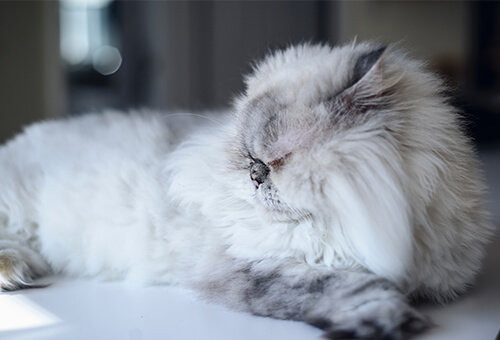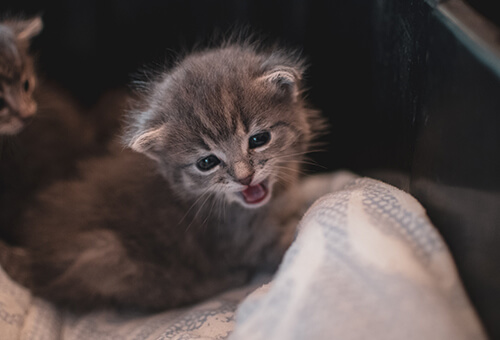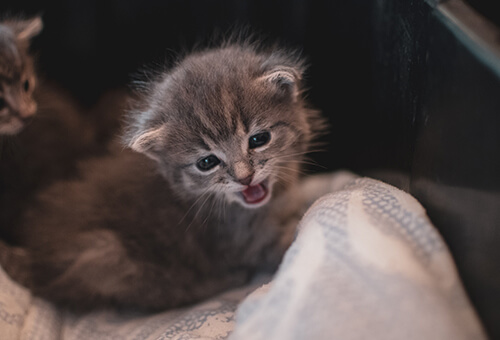These are the 5 signs to know that your cat is in labor
Mammary glands will increase in size
During the final pregnancy, the glands of your cat will increase in size. Her glands are arranged in 2 parallel rows running along the outside body wall that extends from the groin area up to the underside of her chest. Cats usually have 4 pairs of mammary glands. Approximately 2 days before your cat gives birth, she’ll start to produce milk.
Temperature will fall
A cat’s normal temperature falls between 100 Fahrenheit to 103 Fahrenheit (37-39 Celcius). A day or two before giving birth, her temperature will drop to 99 Fahrenheit (37.2 Celcius). How to take your cat’s temperature? You can simply take her temperature in the armpit if she lets you, most of the time there are enough other signs that labor is starting that you won’t need to worry about taking her temperature.
Decrease in appetite
Your cat may have a significant decrease in appetite, it can be caused by the weight of the kittens pushing against their mother’s stomach, or it could simply be a symptom of general anxiety.
Behavior changes
During the final week of the pregnancy, your cat will be hiding out as much as possible in a secluded place in the house, or she will become affectionate, mostly if she has a close relationship or feel trusted with one particular caregiver. Cats that become more affectionate will want the caregiver to be right at hand.
Licking her genitalia
Your cat will be licking her genitalia frequently, there will be discharge from the cat’s vulva a few hours before she begins giving birth. Now is the time you might see your cat pacing, howling and being restless.
Supplies for the birthing
Most of the time, cats will want to hide to give birth. However, you can prepare a birthing area for her, such as a cardboard or laundry basket with towels or blankets. It would be easier for you to observe when it is giving birth. Here are the supplies that you will need:
Absorbent pads
You may use absorbent pads to line the delivery area
Towels
You will need towels or paper towels to clean the area
Nesting box
Before buying a nesting box, you may want to visit the vet with your cat to get an indication of how many kittens your cat is expecting. An average litter is about four kittens, however a cat can have anywhere between 1 to 12 kittens. A standard, 8-pound (3.6kg) cat should be fine with a box that is 16 inches by 24 inches. The larger the cat, the bigger the box it will need.
Dental floss and a pair of sanitized scissors
If the mother cat does not break away the umbilical cord, you will need to tie it off with a piece of dental floss or a string or you may cut the cord with a clean and sanitized scissors.
Refuse bin
You will have a bunch of towels and waste after birth, so have a bin or a box ready to discard them.
Length of time for the total birth process
On average, it takes half a day for it to give birth to all her kittens. The first kitten should arrive within an hour of the start of labor.
In between kittens, the mother cat will rest and should be allowed to nurse and clean the kittens that were born. If you have been keeping the kittens in another box, move them back with the mother cat and help them find a nipple. A break in birthing is a good time for you to feed her food, such as kitten milk replacement and unflavoured yogurt.
A healthy kitten is rarely born after seven hours. If you think there’s more, take her and all the kittens to the vet.

Common problems that she might face during labor
Fortunately, most cats can deliver their kittens without any intervention. However, some complications may occur:
Extended contraction without birth
If your car is having more than 30 minutes of strong contractions without any kittens, take it and any kittens to your vet.
Kitten lodged in the birth canal
Most kittens are born head first, Breech (tail-first) occurs about 40% of the time and are considered normal. A kitten lodged in the birth canal for more than 10 minutes is likely to distress. If your kitten is lodged for more than 2 minutes, call your vet and they will give you the next steps
Postpartum hemorrhaging
Some bleeding after giving birth is normal, excessive bleeding or hemorrhaging is an emergency and requires immediate veterinarian attention. If pro-long, the mother cat can die. If the regular bleeding continues for more than a week after birth or the bleeding stops and then starts again, seek a veterinarian.
Retained placenta
If your cat does not pass each of the placentas, it can lead to uterine infection. Count each of the placentas, even if the mother cat eats it. The number of placentas should equal the number of kittens.
Once all the kittens are born, your queen should be caring for them and feeding them. During nursing, make sure it has ample kitten formula food. A high-quality kitten formula will meet your cat’s high-energy nutritional needs.
If your cat is not eating, seems to be in pain, or any bad effect, something is not right. If there’s a foul odor and bleeding, it indicates an infection or retained kitten. If you have encountered this situation with your cat, seek immediate veterinary care.

